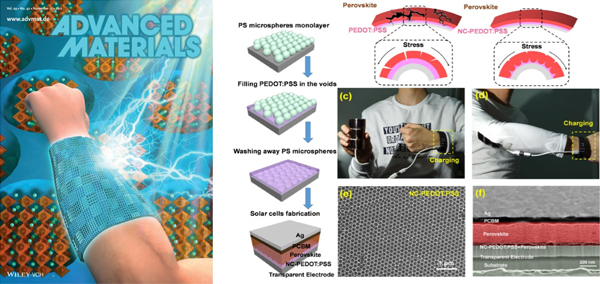


Wearable electronic devices have triggered extensive research interest in the next generation of artificial intelligence equipment. The electric power source is the core part of wearable electronic devices. Generally, most current wearable devices need batteries, even when they are used in places where solar energy is plentiful. Compared with traditional power sources, perovskite solar cells have lightweight, flexible advantages, as well as excellent photovoltaic efficiency. Design of wearable large-scale solar power sources based on perovskite films is important.
Recently, Professor Song Yanlin and his colleagues from the Institute of Chemistry, Chinese Academy of Sciences, developed a nano-cellular scaffold of interfacing layers to build an optical resonant cavity and mechanical buffer layer in flexible perovskite solar cells. The nano-cellular scaffold innovatively solved the critical challenges of reproducibility and stability of large-area flexible perovskite solar cells. It is the first time to fabricate a practical solar-powered wearable, which can supply power for multifunctional electronic devices with a variety of body movements. The achievement has been published in Adv. Mater. (Adv. Mater.2017, 29, 1703236)
The nano-cellular scaffold is fabricated via a facile solution of lithography. The common polymer transporting layer is constructed into cellular shape via an efficient printing process with nano-particles assembly. The nano-cellular scaffold significantly improves the crystalline quality of perovskite films and the light harvesting of solar cell devices. Moreover, this nano-cellular scaffold effectively releases the mechanical stresses of flexible devices to protect the perovskite crystalline layer during bending. The researchers successfully fabricated hysteresis-free, flexible and large-scale perovskite solar cells with recorded efficiencies of 12.3% for 1 cm2 single chip and 8.4% for 24 cm2 solar modules, respectively. The printable nano-scaffold contributes the mechanical design for new laminated devices, which will open the prospect for advances of future flexible and wearable electronics.
For more information, please contact:
Prof. Song Yanlin
Institute of Chemistry, Chinese Academy of Sciences
Email: ylsong@iccas.ac.cn
Source: Institute of Chemistry, CAS